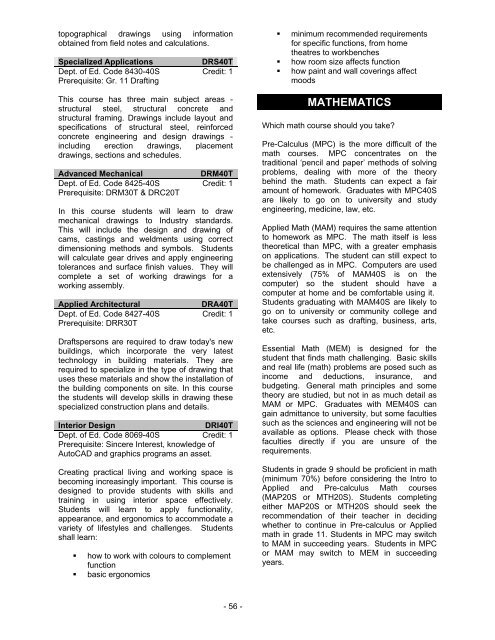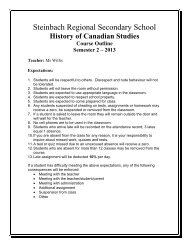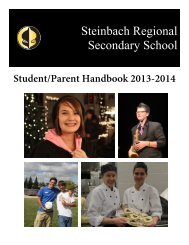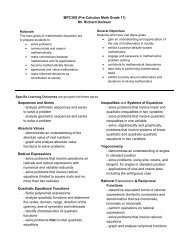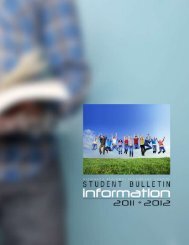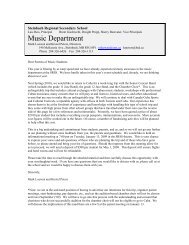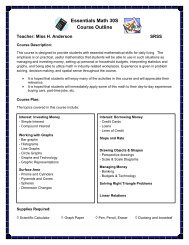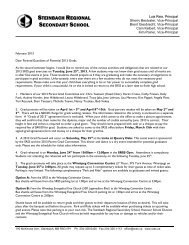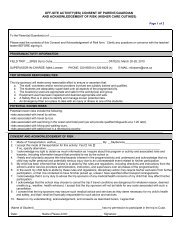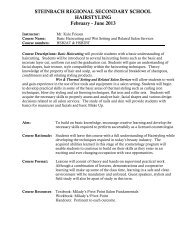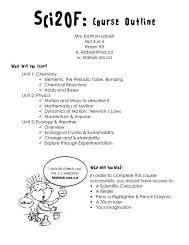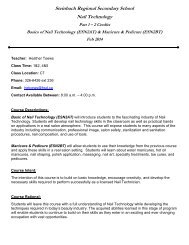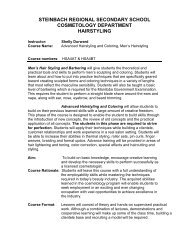SRSS Handbook 2012_13.pdf - Steinbach Regional Secondary ...
SRSS Handbook 2012_13.pdf - Steinbach Regional Secondary ...
SRSS Handbook 2012_13.pdf - Steinbach Regional Secondary ...
Create successful ePaper yourself
Turn your PDF publications into a flip-book with our unique Google optimized e-Paper software.
topographical drawings using information<br />
obtained from field notes and calculations.<br />
Specialized Applications<br />
DRS40T<br />
Dept. of Ed. Code 8430-40S Credit: 1<br />
Prerequisite: Gr. 11 Drafting<br />
This course has three main subject areas -<br />
structural steel, structural concrete and<br />
structural framing. Drawings include layout and<br />
specifications of structural steel, reinforced<br />
concrete engineering and design drawings -<br />
including erection drawings, placement<br />
drawings, sections and schedules.<br />
Advanced Mechanical<br />
DRM40T<br />
Dept. of Ed. Code 8425-40S Credit: 1<br />
Prerequisite: DRM30T & DRC20T<br />
In this course students will learn to draw<br />
mechanical drawings to Industry standards.<br />
This will include the design and drawing of<br />
cams, castings and weldments using correct<br />
dimensioning methods and symbols. Students<br />
will calculate gear drives and apply engineering<br />
tolerances and surface finish values. They will<br />
complete a set of working drawings for a<br />
working assembly.<br />
Applied Architectural<br />
DRA40T<br />
Dept. of Ed. Code 8427-40S Credit: 1<br />
Prerequisite: DRR30T<br />
Draftspersons are required to draw today's new<br />
buildings, which incorporate the very latest<br />
technology in building materials. They are<br />
required to specialize in the type of drawing that<br />
uses these materials and show the installation of<br />
the building components on site. In this course<br />
the students will develop skills in drawing these<br />
specialized construction plans and details.<br />
Interior Design<br />
DRI40T<br />
Dept. of Ed. Code 8069-40S Credit: 1<br />
Prerequisite: Sincere Interest, knowledge of<br />
AutoCAD and graphics programs an asset.<br />
Creating practical living and working space is<br />
becoming increasingly important. This course is<br />
designed to provide students with skills and<br />
training in using interior space effectively.<br />
Students will learn to apply functionality,<br />
appearance, and ergonomics to accommodate a<br />
variety of lifestyles and challenges. Students<br />
shall learn:<br />
• how to work with colours to complement<br />
function<br />
• basic ergonomics<br />
• minimum recommended requirements<br />
for specific functions, from home<br />
theatres to workbenches<br />
• how room size affects function<br />
• how paint and wall coverings affect<br />
moods<br />
MATHEMATICS<br />
Which math course should you take?<br />
Pre-Calculus (MPC) is the more difficult of the<br />
math courses. MPC concentrates on the<br />
traditional ‘pencil and paper’ methods of solving<br />
problems, dealing with more of the theory<br />
behind the math. Students can expect a fair<br />
amount of homework. Graduates with MPC40S<br />
are likely to go on to university and study<br />
engineering, medicine, law, etc.<br />
Applied Math (MAM) requires the same attention<br />
to homework as MPC. The math itself is less<br />
theoretical than MPC, with a greater emphasis<br />
on applications. The student can still expect to<br />
be challenged as in MPC. Computers are used<br />
extensively (75% of MAM40S is on the<br />
computer) so the student should have a<br />
computer at home and be comfortable using it.<br />
Students graduating with MAM40S are likely to<br />
go on to university or community college and<br />
take courses such as drafting, business, arts,<br />
etc.<br />
Essential Math (MEM) is designed for the<br />
student that finds math challenging. Basic skills<br />
and real life (math) problems are posed such as<br />
income and deductions, insurance, and<br />
budgeting. General math principles and some<br />
theory are studied, but not in as much detail as<br />
MAM or MPC. Graduates with MEM40S can<br />
gain admittance to university, but some faculties<br />
such as the sciences and engineering will not be<br />
available as options. Please check with those<br />
faculties directly if you are unsure of the<br />
requirements.<br />
Students in grade 9 should be proficient in math<br />
(minimum 70%) before considering the Intro to<br />
Applied and Pre-calculus Math courses<br />
(MAP20S or MTH20S). Students completing<br />
either MAP20S or MTH20S should seek the<br />
recommendation of their teacher in deciding<br />
whether to continue in Pre-calculus or Applied<br />
math in grade 11. Students in MPC may switch<br />
to MAM in succeeding years. Students in MPC<br />
or MAM may switch to MEM in succeeding<br />
years.<br />
- 56 -


